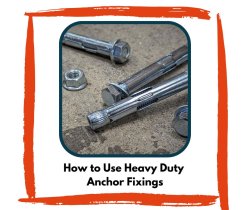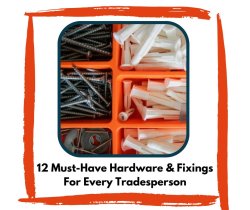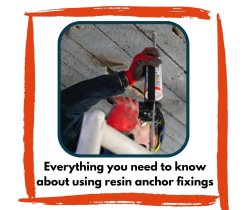How to Use Heavy Duty Anchor Fixings

How to Use Heavy Duty Anchor Fixings
Whether you're fitting steel beams on a commercial job site or mounting a pergola in your back garden, anchor fixings are one of the most reliable ways to secure heavy loads to solid materials like concrete, brick, or stone.
They're a staple in construction, engineering, and advanced DIY projects—and using them correctly is crucial for safety, durability, and long-term performance.
In this comprehensive guide, we’ll explore what anchor fixings are, when and how to use heavy-duty anchor fixings, and what extra considerations you should take into account when working on structural or machinery-based installations.
12 Must Have Hardware & Fixings for Every Tradesperson

12 Must-Have Hardware & Fixings for Every Tradesperson
Whether you're a professional or just starting out in the trade, having the right hardware and fixings at your fingertips can make all the difference between a job well done and a frustrating delay.
From carpenters and electricians to plumbers and general builders, there are certain essential fixings that no tradesperson should be without.
Here’s our comprehensive list of must-have tools and fixings that should be in every toolkit, van, or on-site box. These are the go-to items that keep projects moving and customers happy.
Screwing Into Concrete Using Resin Anchor Fixings

Screwing into Concrete Using Resin Anchor Fixings
When it comes to fixing into concrete, standard screws and plugs often just don’t cut it, especially when you're working with heavy loads, high-stress environments or structural applications. That’s where resin anchor fixings come in.
Ideal for tradespeople across construction, carpentry, metalwork and beyond, resin fixings provide a rock-solid hold in concrete, brick, stone, and other masonry materials. If you're not using resin anchors yet, you're missing out on one of the most reliable and versatile fixings on the market.
In this blog, we’ll walk you through everything you need to know about screwing into concrete using resin anchor fixings – from how they work to when and why you should be using them.
How to Drill into Brick Like a Pro

How to Drill into Brick like a Pro
Drilling into brick is an essential DIY skill, whether you're mounting a TV, putting up shelves, or installing curtain poles.
Unlike plasterboard, brick provides a solid and durable surface for fixings—but you can’t just screw directly into it. You need the right drill, fixings, and rawlplugs to ensure a secure hold.
At Fix and Fast, we know that choosing the right tools and techniques makes all the difference. This guide will walk you through how to drill into brick safely and efficiently, so your fixings stay strong for years to come.
How to Prevent Loose Screws & Bolts

How to Prevent Loose Screws and Bolts
Loose screws and bolts are more than a minor inconvenience—they can lead to equipment failure, leaks, and even safety hazards. But why do they loosen, and how can you stop it?
The fixings experts at Fix and Fast break it all down and offer practical tips to keep your fasteners secure.







